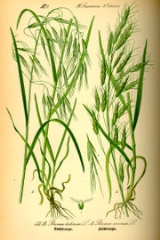
Field Brome
Encyclopedia
Field Brome or Schrader's Brome, Bromus arvensis, is a grass
native to Europe
and Asia
.
It is an annual
bunchgrass, growing to 50–110 cm tall with slender leaves
10–30 cm long and 0.5–1 cm broad. The flower
spikelets are erect at first, later spreading to slightly drooping, 10–25 mm long; flowering is in mid summer.
Poaceae
The Poaceae is a large and nearly ubiquitous family of flowering plants. Members of this family are commonly called grasses, although the term "grass" is also applied to plants that are not in the Poaceae lineage, including the rushes and sedges...
native to Europe
Europe
Europe is, by convention, one of the world's seven continents. Comprising the westernmost peninsula of Eurasia, Europe is generally 'divided' from Asia to its east by the watershed divides of the Ural and Caucasus Mountains, the Ural River, the Caspian and Black Seas, and the waterways connecting...
and Asia
Asia
Asia is the world's largest and most populous continent, located primarily in the eastern and northern hemispheres. It covers 8.7% of the Earth's total surface area and with approximately 3.879 billion people, it hosts 60% of the world's current human population...
.
It is an annual
Annual plant
An annual plant is a plant that usually germinates, flowers, and dies in a year or season. True annuals will only live longer than a year if they are prevented from setting seed...
bunchgrass, growing to 50–110 cm tall with slender leaves
Leaf
A leaf is an organ of a vascular plant, as defined in botanical terms, and in particular in plant morphology. Foliage is a mass noun that refers to leaves as a feature of plants....
10–30 cm long and 0.5–1 cm broad. The flower
Flower
A flower, sometimes known as a bloom or blossom, is the reproductive structure found in flowering plants . The biological function of a flower is to effect reproduction, usually by providing a mechanism for the union of sperm with eggs...
spikelets are erect at first, later spreading to slightly drooping, 10–25 mm long; flowering is in mid summer.

